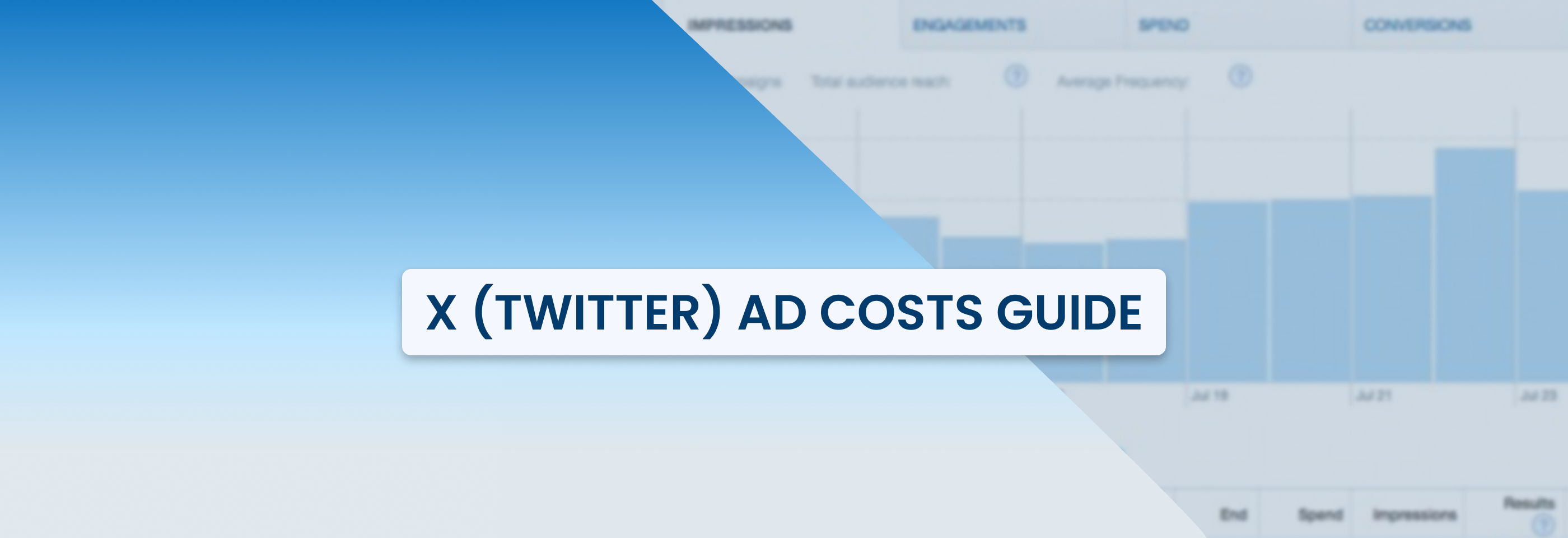How Much Do YouTube Ads Cost? A Quick Guide
2024-07-10
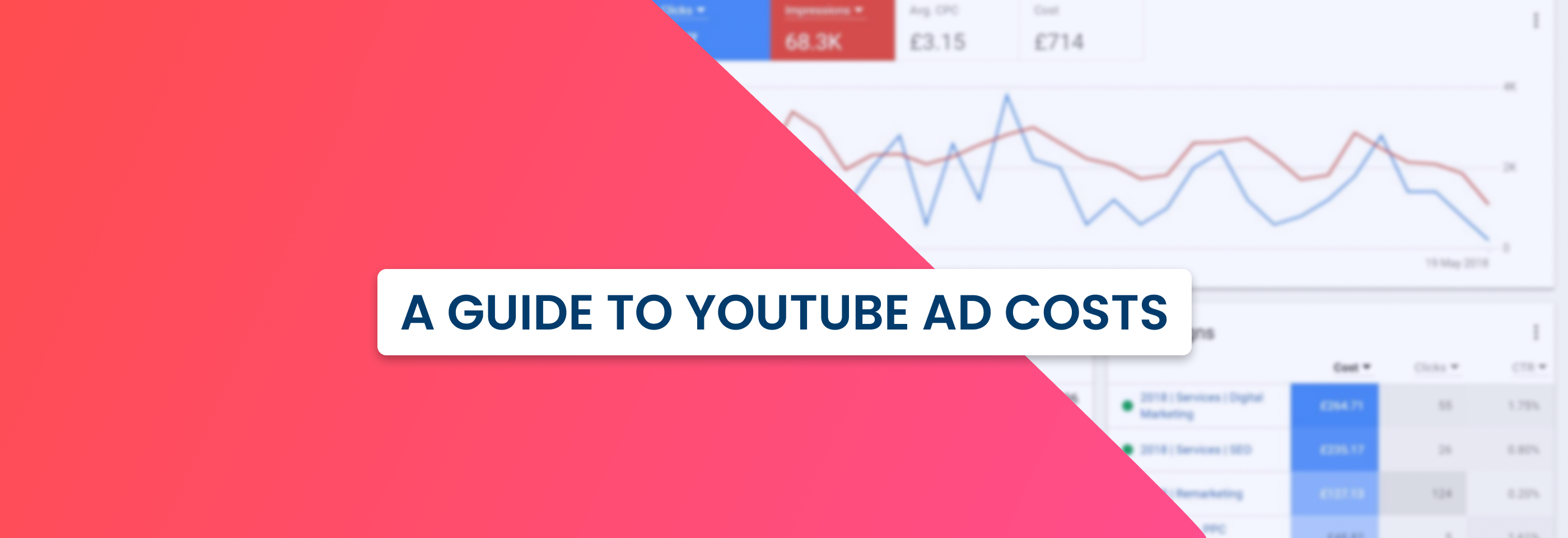
Understanding the costs of advertising on specific platforms can really make a difference in your strategy, especially if we’re talking about video ads that usually take more resources to create.
In our previous article, we covered the basics and benefits of YouTube advertising. Now, we're going deeper into the financial side of things. We'll explain how YouTube charges you for ads, break down the factors that affect ad costs, and share tips to help you make the most of your advertising budget.
Behind the curtain: how much to spend on YouTube ads
First things first, it’s important to understand how YouTube charges advertisers for their ads.
There are two primary models used for YouTube ads:
1. Cost Per View (CPV)
This means that you pay for your ad when someone watches it or interacts with it, like clicking on it. The charge happens after a viewer watches at least 30 seconds of your ad or the entire ad if it's shorter.

2. Cost Per Thousand Impressions (CPM)
Like on other platforms, with CPM you pay based on how many times your ad is shown per thousand views. This model focuses on getting your ad seen by as many people as possible.
Both of these models help you pick the best option for their goals — whether it's boosting brand awareness (CPM) or driving specific actions (CPV). The costs can change based on factors, though, which we’ll talk about later.
For now, let’s get to the specific numbers.
How much do YouTube ads cost per month?
According to WebFX’s survey, a significant portion of businesses (53%) spend between $101 and $1000 per month on YouTube ads. This range shows that you don’t necessarily have to spend a lot if you want to add YouTube in your advertising mix – YouTube ads can fit budgets of all sizes.
If you still think that YouTube advertising is too expensive, check out the guides on advertising costs on other platforms to draw comparisons:
- General Google ad costs;
- Facebook ad costs;
- Instagram ad costs;
- TikTok ad costs;
- LinkedIn ad costs;
- Snapchat ad costs;
- X (Twitter) ad costs
Cost per View (CPV) for YouTube ads
The same survey showed that 43% of businesses spend $0.11 – $0.40 per view on YouTube ads, which is pretty low and comparable to the cost per click on other popular advertising platforms.
Cost per Mile (CPM) for YouTube ads
According to Emarketer, YouTube's advertising costs for every thousand views changed from $13.03 to $15.34 over the past year. This is slightly higher than CPM on some other platforms, but not by a lot.
As you can see, YouTube ads aren’t as expensive as they seem. But obviously, video production in itself will be more costly than creating simple image or text ads, which is something you have to take into account when you’re deciding which advertising platform and format to pick.
Next, let’s consider the key factors that can affect how much YouTube ads can cost you – the more you know, the better prepared you’ll be to make the right choices and run profitable campaigns.
What influences YouTube ad costs?
1. Ad format
One of the key factors that determines how much you’ll have to spend on your YouTube ads is the ad formats you choose. Here’s what you need to keep in mind when choosing each ad format:
Skippable ads
These ads can be skipped after 5 seconds. You only pay if viewers watch at least 30 seconds or interact with the ad, so this format helps keep costs down if people skip.
However, you’ll need to make the first few seconds really engaging to get viewers to stick around. You can look at how many people skip at the 5-second mark versus those who continue watching to analyze ad performance (this data can be found in YouTube Studio's video analytics).
If too many people skip the ad, you need to focus on improving those crucial first 5 seconds.
Non-Skippable ads
These ads must be watched before users can see the video they were looking for. They typically last 15-20 seconds, and since viewers can’t skip them, you pay based on impressions rather than interactions.
This can cause higher costs, but at the same time, guarantee that your full message is seen. You can analyze non-skippable ads’ performance by checking the retention rate and click-through rate (CTR) in YouTube Studio and Google Ads reporting.
Bumper ads
These are very short ads, just 6 seconds long (which is effective for delivering quick messages), and viewers can’t skip them. If you use this ad format, you’ll be charged based on impressions.
Bumper ads usually cost less per impression but are limited in how much information they can convey. You’ll need to monitor the number of impressions and check the retention rates in YouTube Studio to gauge their effectiveness.
Display ads
These appear to the right of the feature video and above the video suggestions list. They are also less intrusive and typically cost less. You’ll be charged based on clicks or impressions if you use them.
TrueView Video Discovery ads
These ads appear in YouTube search results or next to related videos. You pay when someone clicks on the thumbnail to watch your ad. This can be cost-effective for driving targeted traffic, but it requires a compelling thumbnail and title to attract clicks.
To measure how effective these ads are, check the number of clicks and how well those clicks convert into desired actions.
As always, choosing the right ad format depends on your campaign goals and budget, and only you can decide what’s more important for you: the potential ad costs or the results you can achieve with them.
2. Type of budget
The type of ad budget you choose for your YouTube ads will affect your overall costs and the results of your advertising campaigns. Here’s how different budgeting options influence ad costs:
Average Daily Budget
Setting an average daily budget determines the maximum amount you’re willing to spend each day on a campaign. For example, if you set a daily budget of $50, that’s the most you’ll spend in a day.
This provides you with a consistent spending framework, helping you manage costs daily. It’s predictable, so you won’t have any unexpected budget overruns.
Daily Spending Limit
The daily spending limit is calculated by multiplying your average daily budget by 2. So, with a $50 daily budget, your limit could be up to $100 if needed.
This gives you flexibility to spend more on days where your ads might get higher engagement or conversions, so it can lead to increased exposure but also potentially higher costs on active days.
Monthly Spending Limit
Calculated by multiplying the average daily budget by 30.4, this sets a cap on your monthly spending. For example, with a daily budget of $50, your monthly cap would be approximately $1,520.
This helps you plan and control your total spending over longer periods, aligning with your financial goals.
Shared Budgets
Shared budgets allow you to allocate a total budget across multiple campaigns. For example, if you allocate $200 per day shared between two campaigns and one spends only $100 on a given day, the remaining $100 can be reallocated to the other campaign.
This maximizes your total ad budget by making sure every dollar is used effectively across related campaigns.
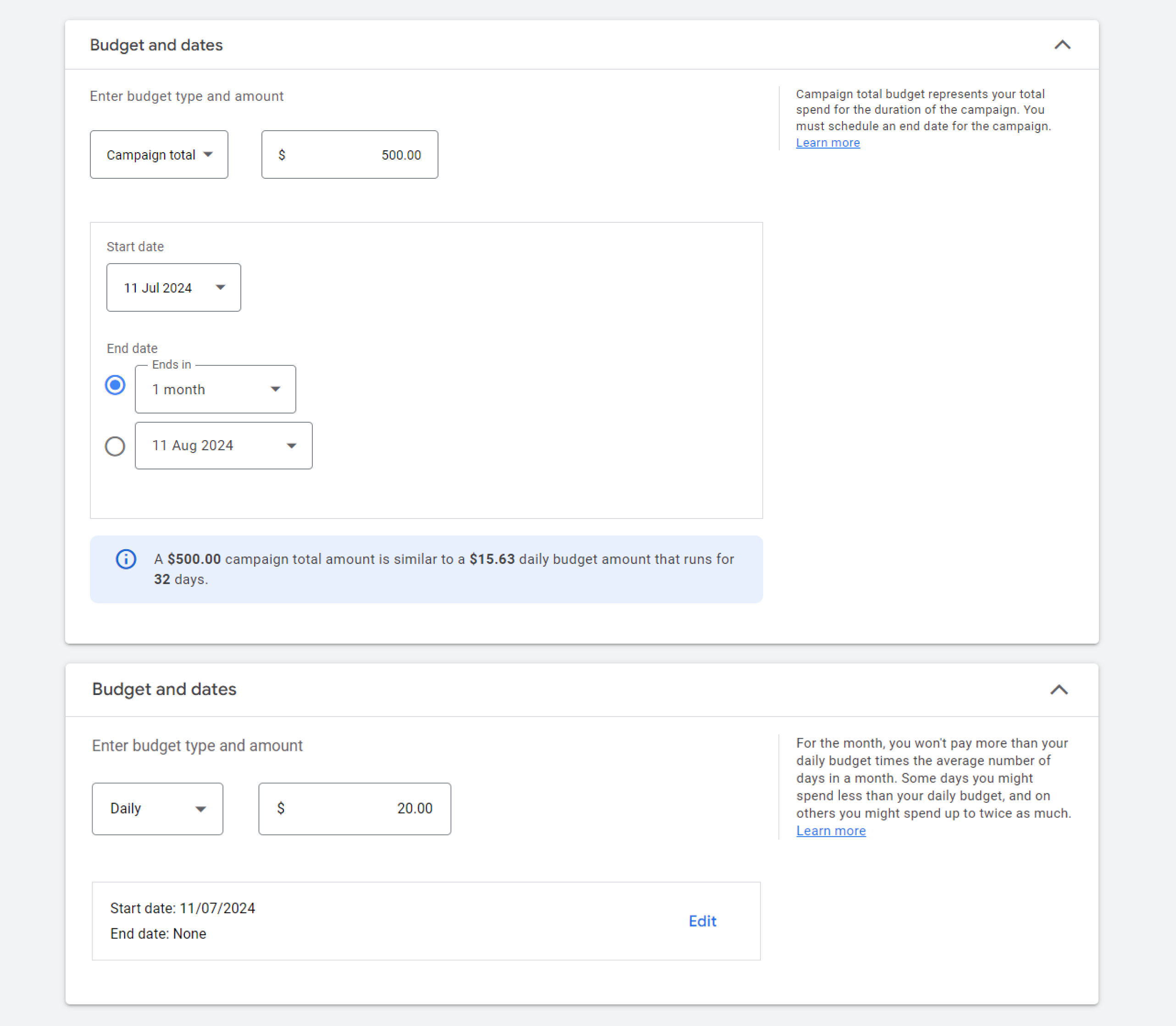 You can set both daily and campaigns budgets for your video ad campaigns.
You can set both daily and campaigns budgets for your video ad campaigns.
Campaign Total Budget
This sets a strict limit on spending for the entire duration of a campaign. So, even if your ads get more views than expected, you won’t exceed this budget.
It provides you with strict control over overall campaign costs by limiting spending to a predefined amount. which is great for campaigns with fixed budgets or specific financial plans.
The baseline is that the type of ad budget you select — whether average daily, daily spending limit, monthly spending limit, shared budget, or campaign total budget — fundamentally shapes how you allocate and manage your advertising spend on YouTube.
Each choice offers different benefits in terms of controlling costs, adjusting budgets easily, and improving how well your ads work to reach your business goals.
3. Bidding strategy
Each bidding strategy has its own benefits for YouTube ads based on what you want to achieve with your campaign — getting more people to see your ads, making more sales, or getting the best return on your ad spend. It also affects how much you’re going to spend.
Here is an overview of the main bidding strategies available on YouTube:
Target CPM (Cost Per Thousand Impressions)
With Target CPM, you pay for every thousand times your ad is shown. This is great for getting your brand in front of a lot of people, especially if you’re just trying to get noticed. But remember, it focuses on how many times your ad is seen, not necessarily watched (which can mean lower engagement).
Target CPV (Cost Per View)
Target CPV means that you pay when someone watches 30 seconds of your video or interacts with it (e.g. clicks on call-to-action overlays). This is ideal if you want people to engage more deeply with your content.
You can set the highest amount you’re willing to pay per view, i.e. your maximum CPV bid. Your actual cost can often be less than that, depending on the competition. That being said, bidding for views can be more expensive compared to CPM bidding: your ads have to be engaging to keep viewers watching.
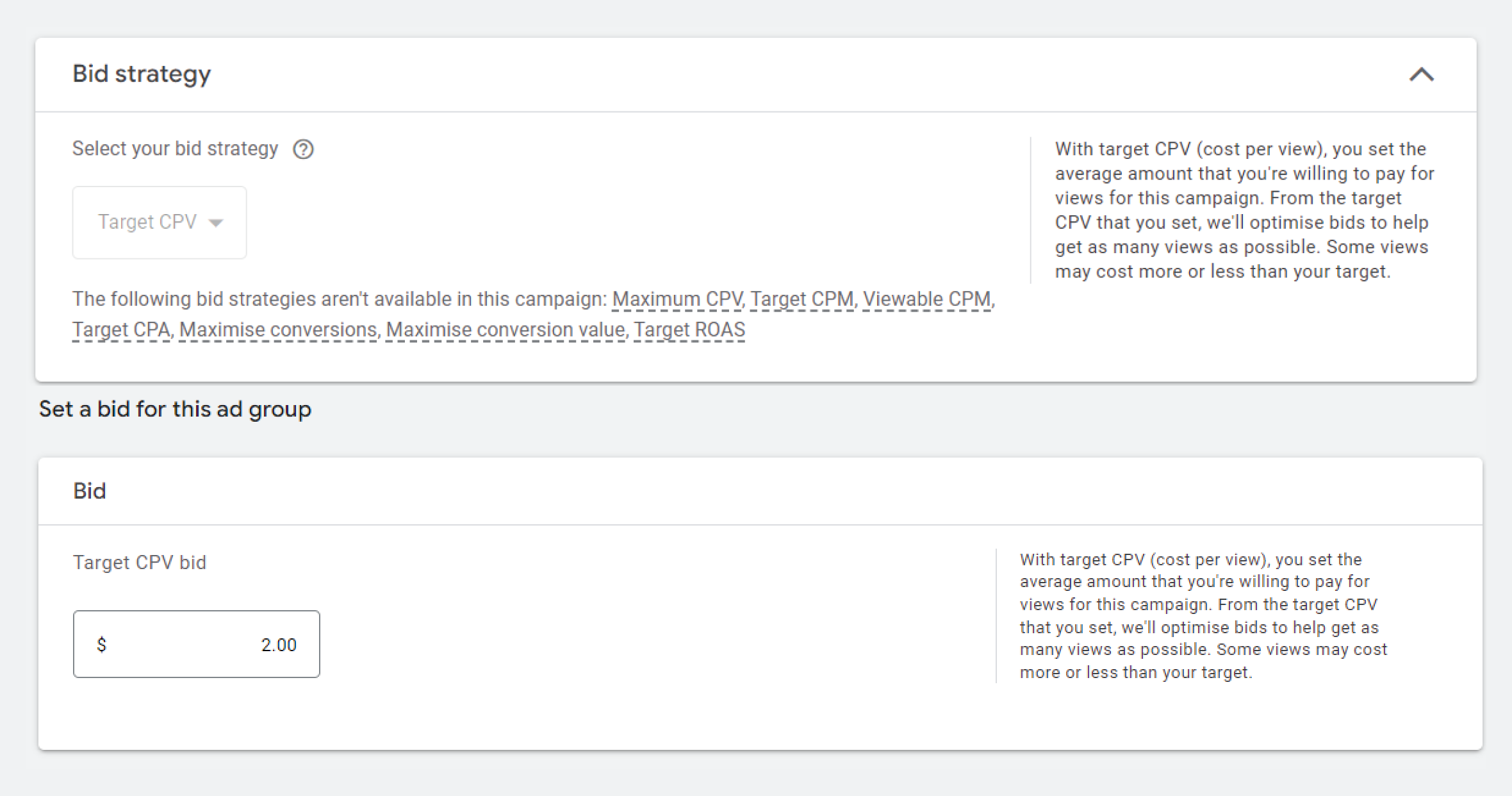 Your bid strategy choice will depend on your campaign's subtype. For example, for campaigns aimed at getting video views, you can only choose the Target CPV strategy.
Your bid strategy choice will depend on your campaign's subtype. For example, for campaigns aimed at getting video views, you can only choose the Target CPV strategy.
Target CPA (Cost Per Action)
The Target CPA bidding strategy is useful for campaigns focused on getting people to take specific actions, like making a purchase or signing up. Google will optimize your YouTube ads to get these actions at the cost you want to pay.
This can help you drive actual conversions, making it great for ROI-focused campaigns. But it can also be be more costly per conversion, so you need to correctly configure your CPA settings to avoid overspending.
Maximize Conversions
This is a bit like the Target CPA bidding strategy, but fully automated. Google will set the bids to get the most conversions possible within your budget, which is great for maximizing results without constant adjustments.
But as it’s automated, you have less control over individual bids. So, it might be more expensive if budget limits aren’t set properly.
Picking the best strategy means thinking about your goals, how much you can spend, and how much control you want over your bids.
4. Campaign goals
When you plan YouTube ad campaigns, start by setting clear goals. Unlike ads focused on immediate sales, YouTube ads are effective for boosting brand visibility and generating interest, so you have to understand what outcomes to expect beforehand.
Before you start your campaign, decide what you want to accomplish. Do you want more people to know about your brand, watch your videos, or change how they think about your brand? Different goals affect how much you’ll spend on YouTube ads.
Here’s how:
- Sales and Leads: these types of campaigns aim to get people to take action right away, like buying something or signing up. Ads focused on these actions might cost more because they’re designed to get results quickly. That’s why you might want to use automated bidding strategies to spend your budget more rationally;
- Website Traffic: this type of campaign focuses on getting more people to visit your website. You’ll likely pay based on how many people click on your ad or how many times it’s seen (i.e. impressions). If you use manual bidding, you can control how much you pay for each action, which will affect your total costs;
- Awareness and Consideration: these campaigns work to build awareness and influence how people think about your brand. Bidding strategies like cost per view (CPV) or viewable CPM (vCPM) are often used here to get your ad seen more and increase engagement over time;
- Reach and Frequency: these campaigns help you make sure lots of people see your ads often. Bidding strategies that focus on reaching a wide audience (like CPM bidding) ensure your ads get seen more frequently. Costs can change depending on how much competition there is and who you’re targeting.
Setting clear goals for your YouTube ads helps you make smarter decisions about your budget and achieve meaningful results.
5. Target audience
When you're planning your YouTube ad campaigns, one important factor to consider is your target audience. Who you choose to target can greatly affect how much you'll spend. Here's why:
- Competition for ad space: if many other advertisers are trying to reach the same audience as you, the cost of showing your ad to that group goes up. YouTube uses an auction system for ad placements, so more competition means higher bids and higher costs for you;
- Audience size and specificity: how big and precise your target audience matters too. A very specific audience with particular interests and demographics might be more expensive to reach, while a larger, more general audience can be cheaper, but your ad might not be as targeted;
- Ad relevance and engagement: YouTube, just like all other ad platforms, prioritizes ads that are relevant and engaging. If you choose the right audience and your ads resonate with them, you might end up spending less;
- Geographic targeting: targeting certain geographic areas can also impact costs. Advertising in high-cost regions or areas with more economic activity can be more expensive than in less affluent areas.
If you understand how to balance reach, specificity, and engagement when selecting who will see your YouTube ads, you can optimize not just ad performance but also budget spending.
6. Seasonality and demand
The price of YouTube ads can also go up and down depending on what's happening in the world and online.
Think of it like this: when a lot of businesses want to advertise at the same time, the cost to show your ad can go up because everyone is fighting to be in the spotlight.
For example, this can happen because of seasonal trends, like holidays such as Christmas, Black Friday, or Valentine's Day. More people will be interested in buying things, and the competition among advertisers can make the costs go higher. Special events like back-to-school sales or new product launches can also raise ad costs until things calm down after the event.
There can also be specific seasonal changes and trends in different industries, like retail or travel, that impact advertising costs. For example, travel ads might cost more during vacation seasons.
All of this is to say that you need to keep an eye on these trends and adjust your plans accordingly to make sure you’re getting the best value for your money.
7. Ad Quality and Relevance
Creating ads that are high-quality and relevant to your audience is crucial for getting good results with your YouTube campaigns instead of wasting your ad money.
When your ad is high-quality, looks and sounds good, people are more likely to pay attention to it and interact with it. This can lead to better engagement rates, more people watching your video all the way through, clicking on your ad, and so on.
Relevance is also important because it means that you’ve selected the right target audience and that your ads are being shown to people who are interested in your offers.
Now, why does this matter for costs?
YouTube (and broadly, Google) wants to show ads that people like to see. So, if your ad is high-quality and relevant, YouTube is likely to give it more opportunities to be shown and you won’t have to spend more to bid in an ad auction.
In a nutshell, YouTube rewards good ads with better visibility. On the other hand, if your ad isn’t very good or isn’t relevant to your audience, people might ignore it or skip it. This can lower your engagement rates and thus make your ad more expensive. So, when you’re creating your YouTube ads, think about making them the best they can be.
How to lower YouTube ad costs?
Now that you know about everything (well, not everything, but at least the most important things) that can affect the costs of your YouTube ads, you probably want to learn how to optimize them as well.
Here are the key strategies that can help you with that:
Choose the right ad format
Here’s a breakdown of different ad formats and why you might want to choose them:
- Skippable ads: these ads are budget-friendly because you pay based on how much viewers engage with them. You can choose them for grabbing attention early and reaching a broad audience interested in your message;
- Non-Skippable ads: with them, you pay for each time your ad is shown, which can be more expensive. But you're guaranteed that viewers see your entire message. Use them for campaigns focused on actions like selling products or getting sign-ups, where making sure viewers see your whole ad matters most;
- Bumper ads: they usually cost less per view compared to longer ads. Use them for quick, memorable messages and building brand awareness by grabbing attention fast;
- Display ads and TrueView discovery ads: both offer flexibility depending on whether you want viewers to click or simply see your ad. Use them for campaigns aiming to get people to visit your website or buy something specific.
 You can use Google's new multi-format ads option to add more variety to your campaign and potentially get a higher ROAS.
You can use Google's new multi-format ads option to add more variety to your campaign and potentially get a higher ROAS.
Picking the right ad format that matches your goals is crucial for making the most of your ad budget, so choose wisely.
Optimize audience targeting
In some cases, narrow audiences can be more cost-effective, so here are some targeting options you might want to use if you think they will suit your business:
- Demographics: aim your ads at people based on their age, gender, and where they live to make sure they see what’s relevant to them;
- Interests and custom intent: select viewers for your ads by what they’re into and what they’ve been looking up online, aiming for those who are most likely to be interested in your videos;
- Life events: focus on people going through big life moments that connect with your products or services, making your ads more fitting and possibly saving money by getting better responses.
In other cases, though, it might be best to stick to broad targeting, especially if your competitors are also going after your primary audience.
If you’re not sure what will work best for you, try testing different targeting approaches, compare the results you get, and then scale ad groups with audiences that react to your ads better.
Set a suitable daily budget
You can start with a daily budget that aligns with your campaign goals and follow these simple steps:
- Begin with a budget that allows you to test different ad formats and targeting strategies while still maintaining control over daily spending;
- Adjust your budget based on campaign performance and make sure you allocate resources effectively to achieve what you want;
- Consider lower-cost ad formats like Skippable Video Ads to maximize your budget while achieving higher viewer engagement.
This can help you manage your advertising costs more effectively while optimizing your campaign’s impact and reach.
Monitor and adjust based on performance
Tracking and improving ad performance is also crucial for optimizing your advertising costs. So, keep an eye on how your ads are doing and make changes as needed:
- Keep track of important metrics like how many people are engaging with your ads, how much each view costs (CPV), how frequently people see your ads, etc.;
- Scale ads that perform well by spending more on them or running them for new audience segments;
- Figure out which ads aren’t working that well and make sure you’re not wasting money on them by either optimizing or pausing them.
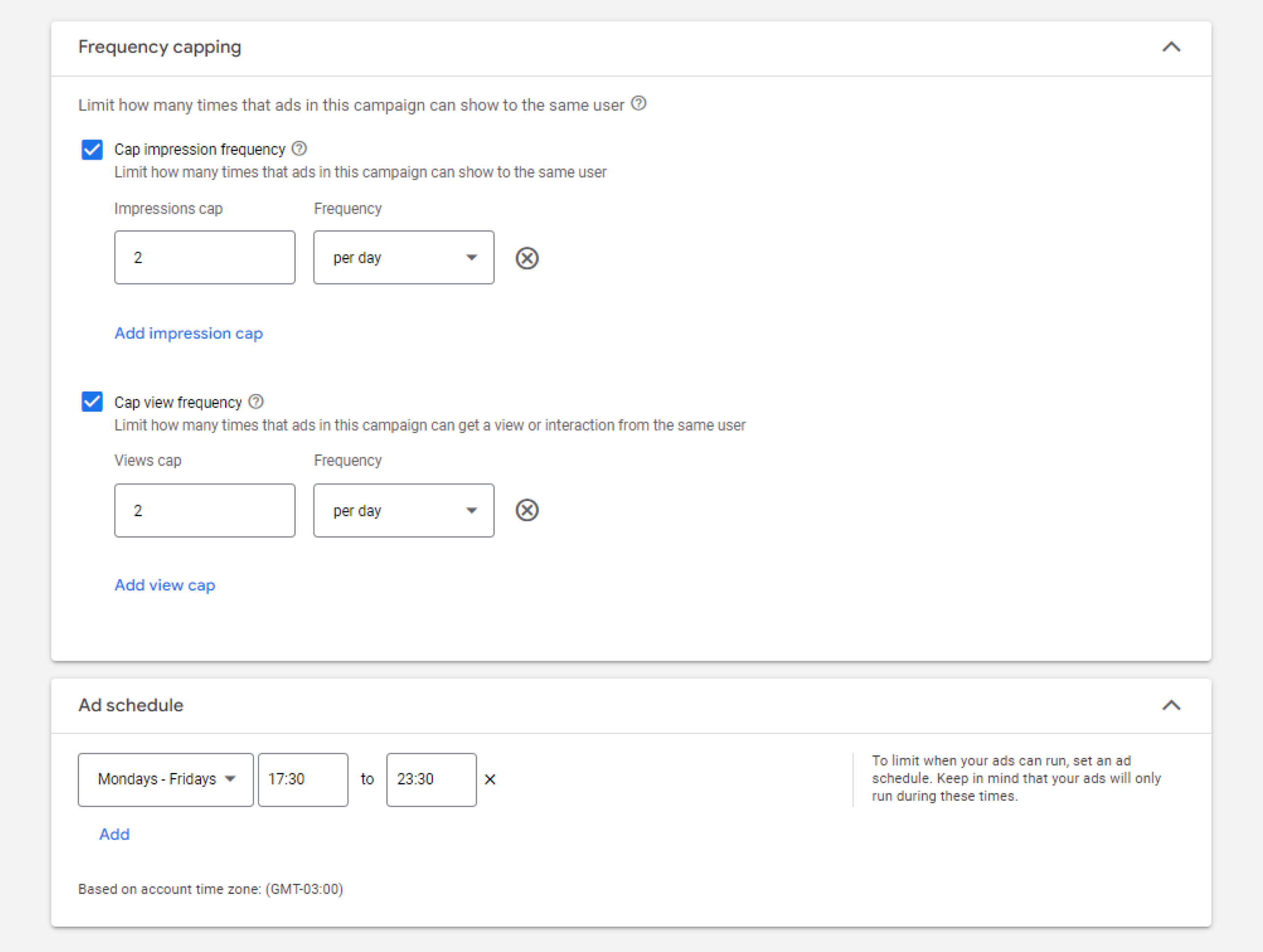 You can set the caps for how frequently users can be exposed to or view your video ads to avoid ad fatigue and reduce budget waste. Setting a specific schedule for showing your ads can also help you spend your money more rationally (like only during the times when people are more likely to engage).
You can set the caps for how frequently users can be exposed to or view your video ads to avoid ad fatigue and reduce budget waste. Setting a specific schedule for showing your ads can also help you spend your money more rationally (like only during the times when people are more likely to engage).
By always checking and adjusting based on how well your ads are doing, you can make sure you’re spending money in the smartest way possible to reach your goals.
Take advantage of timing and trends
Take advantage of peak periods like holidays or big events when people are more likely to be online and engaging with content. This ensures your ads reach a larger and more receptive audience.
Adjust your bidding strategies during these busy times to get the best bang for your buck. You want to maintain cost efficiency while making sure your ads are seen by as many potential customers as possible.
Another tip is to stay flexible with your budget. Sometimes, increasing your daily spending limit a bit during these peak periods can help you capture more attention and engagement.
It's also smart to plan your campaigns around seasonal trends or major industry events. For example, if you sell outdoor gear, ramp up your advertising efforts in the spring when people are getting ready for hiking and camping season.
By keeping an eye on these trends and adjusting your strategy accordingly, you can make your YouTube ads more effective and get the most out of your advertising budget. It's all about reaching the right people at the right time with the right message.
Recap
Knowing how YouTube ads work and how much they can cost you is key for running campaigns that bring you profits or help you make your brand more recognizable.
By learning about CPV and CPM pricing models, considering factors like ad formats, budgets, audience targeting, etc., and following the simple tips for optimizing ad costs, you can make better decisions. Whether you want more people to know about your brand or take specific actions, using these insights helps you spend wisely and get the best results from your YouTube ads.

